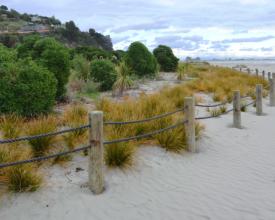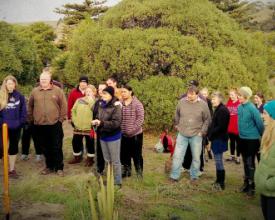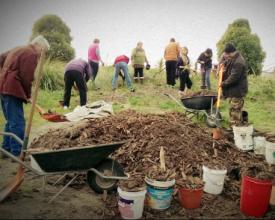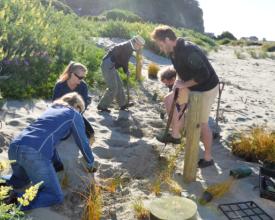
Enfoques comunitarios para restaurar la biodiversidad en los parques costeros
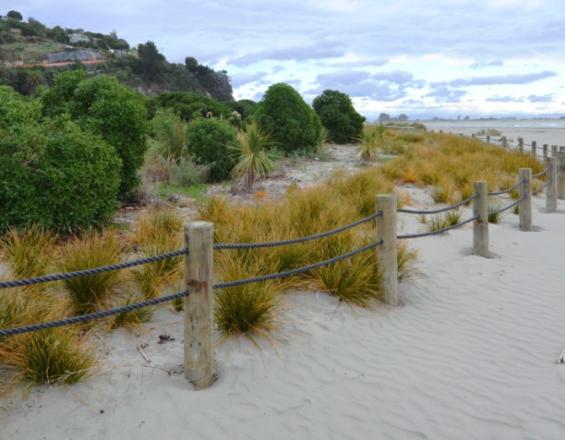
La restauración y protección de la biodiversidad en los parques costeros para hacer frente a la degradación de las dunas puede aportar soluciones a otros problemas. En Nueva Zelanda, estas soluciones incluyen la protección contra los riesgos costeros, la provisión de recursos de fibra vegetal de importancia cultural y la mejora del carácter natural y los valores recreativos del litoral. La clave para garantizar la mejor gama de beneficios es un enfoque basado en el lugar y centrado en la comunidad que identifique primero cómo la gestión de los parques puede ayudar a las comunidades locales.
Contexto
Défis à relever
En Nueva Zelanda, y en todo el mundo, urge conservar la biodiversidad de los ecosistemas de dunas costeras como consecuencia de las pautas de desarrollo humano. Se han desarrollado métodos de protección y restauración de dunas, pero la implicación de la comunidad es esencial para garantizar beneficios duraderos. El cambio climático planteará nuevos y graves problemas a muchos ecosistemas dunares, por lo que es fundamental planificar con antelación para obtener resultados satisfactorios. La ordenación del territorio y el diseño de áreas protegidas desempeñan un papel clave.
Ubicación
Procesar
Resumen del proceso
Bloques de construcción
Enfoque comunitario
La implicación de la comunidad en las actividades de restauración es especialmente importante en el caso de las dunas, ya que los hábitats dunares están expuestos a numerosas amenazas humanas. La principal estrategia consiste en fomentar el sentido de pertenencia no sólo de la comunidad local, sino también de la comunidad playera en general. Esto puede lograrse mediante la concienciación con el objetivo de socializar la visión del parque costero, lo que a su vez tiene el potencial de reducir los problemas de gestión. También es útil sondear directamente el nivel de apoyo a las intervenciones propuestas, idealmente como parte del ejercicio de planificación de la gestión .
Factores facilitadores
- Ofrecer una gama de actividades que se adapten a diferentes grupos demográficos y de interés. Entre ellas se incluyen diferentes versiones de las actividades de restauración y mantenimiento de dunas para adaptarse a diferentes edades y capacidades (por ejemplo, escuelas, grupos empresariales, organizaciones de voluntarios y abejas obreras en general).
- Ofrecer oportunidades de participación a grupos ajenos a la comunidad.
- Fomentar la investigación sobre aspectos del proyecto, incluida su eficacia.
Lección aprendida
La disponibilidad y el entusiasmo de los voluntarios de la comunidad (tanto individuos como grupos) han sido importantes para el éxito del proyecto. En general, la hipótesis de trabajo es que una diversidad de "puntos de aceptación" arrojará los mejores resultados en términos de enfoque comunitario. Las estrategias eficaces tienen que ofrecer oportunidades de participación que se adapten a los distintos grupos de la comunidad en general y también abordar la sostenibilidad de las aportaciones clave de los voluntarios. Es importante garantizar que los principales organizadores dispongan de recursos suficientes y tomar medidas para reducir la probabilidad de agotamiento. Disponer de una estrategia de sucesión es otra idea útil, y en la práctica puede lograrse dando cabida a "sangre nueva" entusiasta siempre que surja la oportunidad. Esto tiene la ventaja añadida de repartir la carga de trabajo y puede ser útil si surge la oportunidad de ampliar el proyecto, tanto en alcance como en escala.
Investigación sobre la eficacia de los métodos de restauración
La investigación sobre la eficacia de los métodos de restauración ha resultado muy valiosa para abordar el problema de la degradación de las dunas en Nueva Zelanda. Esta información ha ayudado a los proyectos dirigidos por la comunidad tanto en el diseño como en la ejecución de las iniciativas. Trabajar con una base de conocimientos sólida es importante para todos los proyectos de restauración, pero especialmente crítico para los proyectos comunitarios en los que las aportaciones voluntarias son elevadas. Estos conocimientos no sólo aumentan las probabilidades de éxito desde el punto de vista de la ecología de la restauración, sino que también mejoran el grado de confianza de los participantes en lo que intentan hacer. La aplicación de este elemento básico depende en gran medida de la aportación profesional a los problemas que se abordan. En Nueva Zelanda se ha investigado mucho sobre el éxito de los métodos de restauración de los ecosistemas de dunas con especies autóctonas. Esto incluye aspectos como los métodos para la recolección de semillas, la propagación y el restablecimiento de especies vegetales de dunas en diversos lugares, y para la gestión eficaz de los lugares de restauración con respecto a amenazas como las malas hierbas y las perturbaciones físicas. Y lo que es más importante, estos estudios han identificado técnicas prácticas y eficaces para alcanzar los objetivos de biodiversidad .
Factores facilitadores
- Financiación de la investigación, proyectos piloto y ensayos de técnicas potencialmente útiles.
- Creación y apoyo de programas de seguimiento como parte integrante de los proyectos de restauración. Esto puede contribuir a la ejecución de dichos proyectos y permite a otros aprender de los resultados obtenidos y de los métodos utilizados.
- Realizar actividades de divulgación e intercambio de información sobre aspectos del diseño de proyectos que puedan ser útiles para otros grupos.
Lección aprendida
Aprender del éxito de inversiones anteriores es muy útil para tomar decisiones que ayuden a evitar errores comunes. Entre los ejemplos de restauración de dunas se encuentran los ensayos que han demostrado una elevada mortalidad al intentar restablecer especies fijadoras de arena mediante la plantación directa con esquejes, y unos resultados considerablemente mejores si los esquejes se cultivan previamente en viveros o a partir de semillas. Otros ejemplos son el grado en que la protección de los herbívoros puede ayudar a proteger las plántulas y la eficacia de distintos métodos para reducir el impacto de las perturbaciones humanas. A pesar de la ventaja que puede suponer la investigación previa, las decisiones no siempre son fáciles de tomar a nivel de proyecto local, especialmente cuando es necesario comprometer fondos u otros recursos. Adoptar un enfoque adaptativo puede ser una estrategia complementaria útil. Por ejemplo, cuando las condiciones locales del lugar no se hayan investigado a fondo, el método de ensayo y error puede ser una forma práctica de diseñar y gestionar un proyecto.
Seguimiento de los resultados
El seguimiento sirve sobre todo para evitar que se repitan los errores y permitir un enfoque adaptativo de la gestión. Esto es especialmente importante cuando no se han investigado a fondo las condiciones locales del lugar, como es el caso de nuestro proyecto y es habitual en las iniciativas dirigidas por la comunidad. El ensayo y error puede ser una forma práctica de diseñar y gestionar un proyecto en estas situaciones, y el seguimiento periódico es esencial para detectar tendencias indeseables cuanto antes. Hemos aplicado el seguimiento a varias escalas. A escala de senderos pequeños, por ejemplo, para probar distintos métodos de restauración de las dunas antes de ampliarlos. A escala de todo el sitio, el seguimiento ha sido muy útil para mostrar el nivel de éxito con respecto a los objetivos a largo plazo, lo que a su vez ha ayudado a conseguir apoyo para el proyecto y a planificar la gestión en el futuro. Algunos ejemplos son la medición del crecimiento de las plantas, la mortalidad y los cambios en el perfil de las dunas a lo largo del tiempo, junto con los registros de los insumos necesarios para lograr diversos resultados. También hacemos un seguimiento de la dimensión humana, como las experiencias de los participantes en el proyecto y las perspectivas sobre las prioridades de gestión.
Factores facilitadores
- Desarrollo y experimentación de nuevas técnicas de seguimiento, especialmente de métodos adecuados para un amplio abanico de usuarios finales (por ejemplo, en el sector comunitario) o cuando se desarrolle una serie de métodos que se adapten a distintos usuarios finales.
- Elaboración de material de orientación para ayudar a los profanos y a los grupos comunitarios a diseñar y aplicar programas de seguimiento sólidos. Esto es especialmente importante en el contexto del seguimiento de proyectos comunitarios.
- Financiación de programas de seguimiento y análisis/comunicación de los resultados.
Lección aprendida
Hemos comprobado que el seguimiento y la transmisión de información a los implicados pueden ser útiles como factor de motivación. La información también tiene utilidad práctica para conseguir la aprobación de las autoridades o patrocinadores clave para la financiación. Recientemente hemos ampliado el seguimiento a la dimensión humana para medir los aspectos del proyecto que interesan a los participantes. Esto está resultando útil para el diseño y la planificación de los proyectos. La selección de los parámetros adecuados para el seguimiento sigue siendo una preocupación clave. Lo ideal es que no sean sólo de interés académico y representen aspectos tangibles buscados por las partes interesadas. Para ello, combinamos el diseño de las actividades de seguimiento con encuestas sobre la percepción de las partes interesadas, con el fin de determinar los valores clave que deben supervisarse desde distintos puntos de vista. De este modo, el seguimiento nos ayuda a calibrar el éxito de la gestión en función de las necesidades de las partes interesadas. Aunque no es posible supervisar todos los aspectos de interés potencial, esto ayuda a sacar el máximo partido de las actividades de supervisión.
Impactos
El seguimiento ha demostrado que las técnicas de restauración son eficaces para restablecer las dunas costeras de Nueva Zelanda. El aumento de la abundancia y la cobertura de las especies vegetales autóctonas de las dunas y la persistencia de las formas del relieve dunar son algunas de las medidas del éxito. A nivel de especies, hay varias especies amenazadas y en peligro que dependen de las dunas. A nivel de ecosistema, tanto los sistemas de dunas "activos" como los "estabilizados" son prioritarios para la protección debido a su declive histórico. Otra característica de muchos proyectos neozelandeses de restauración de dunas ha sido el enfoque comunitario. A nivel de gestión, la implicación de la comunidad se ha visto facilitada por iniciativas como los proyectos "Coastcare", que ofrecen oportunidades de participación pública. Los efectos positivos de este enfoque incluyen el aumento de la concienciación y la comprensión de las necesidades de conservación de las dunas, así como beneficios directos para la gestión gracias a las contribuciones de voluntarios a los trabajos de restauración.
Beneficiarios
- Comunidad local
- Comunidad más amplia
- Tangata whenua (gente de la tierra) - por los valores culturales y tradicionales
- Generaciones futuras
- Especies autóctonas
